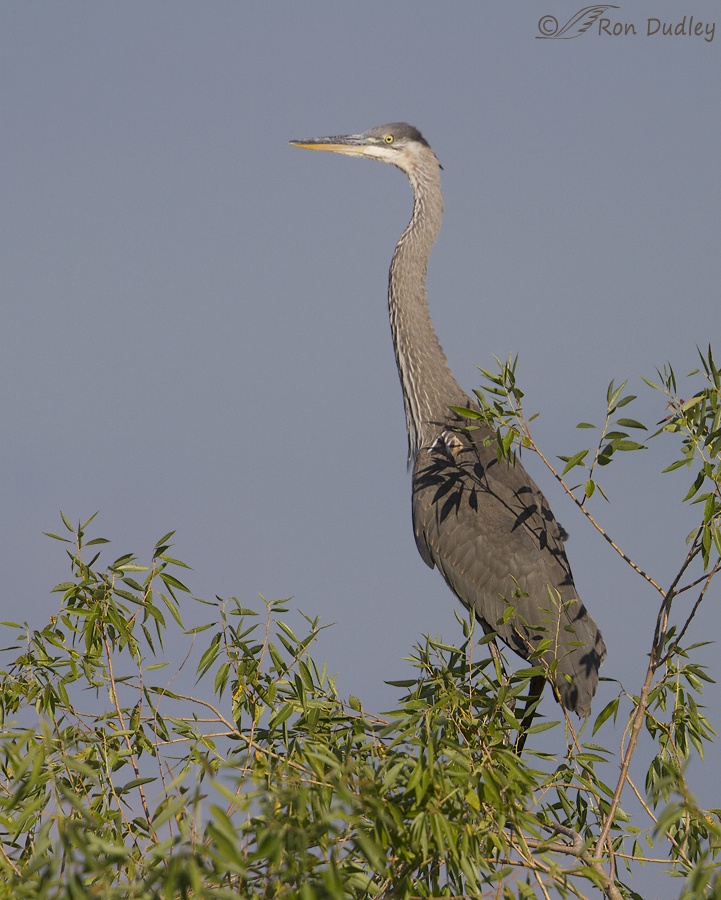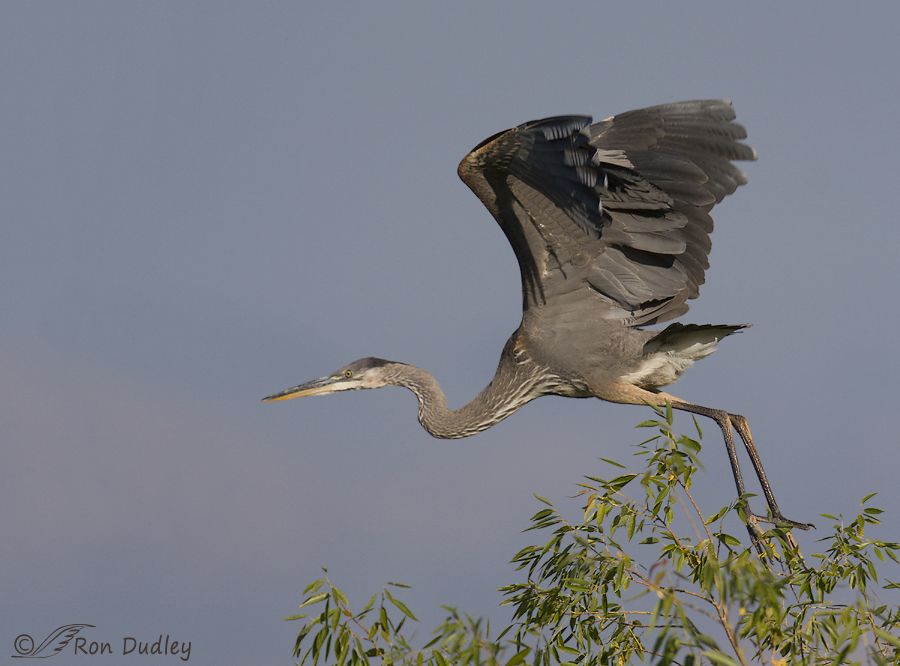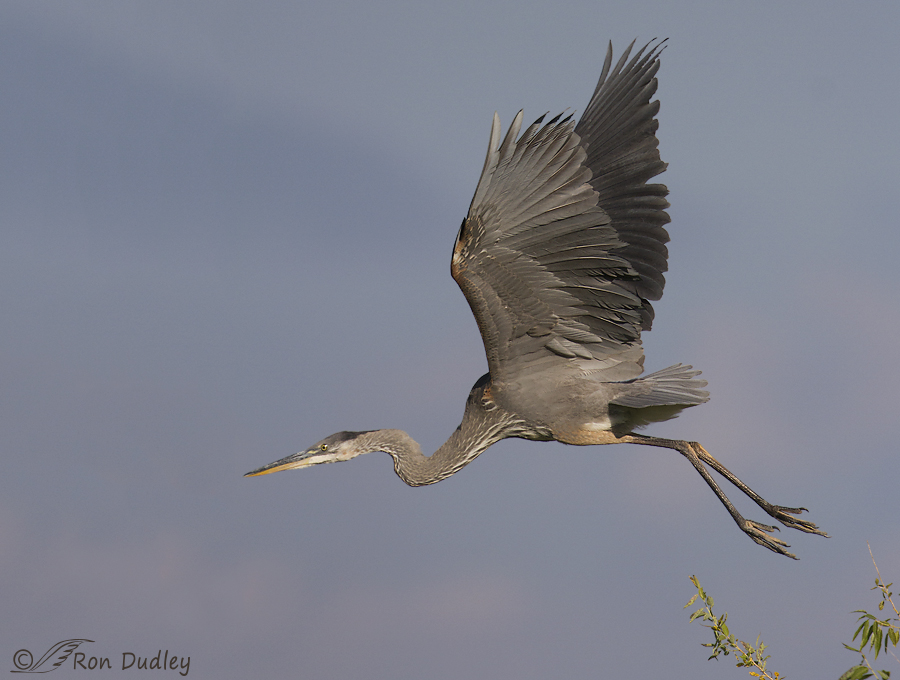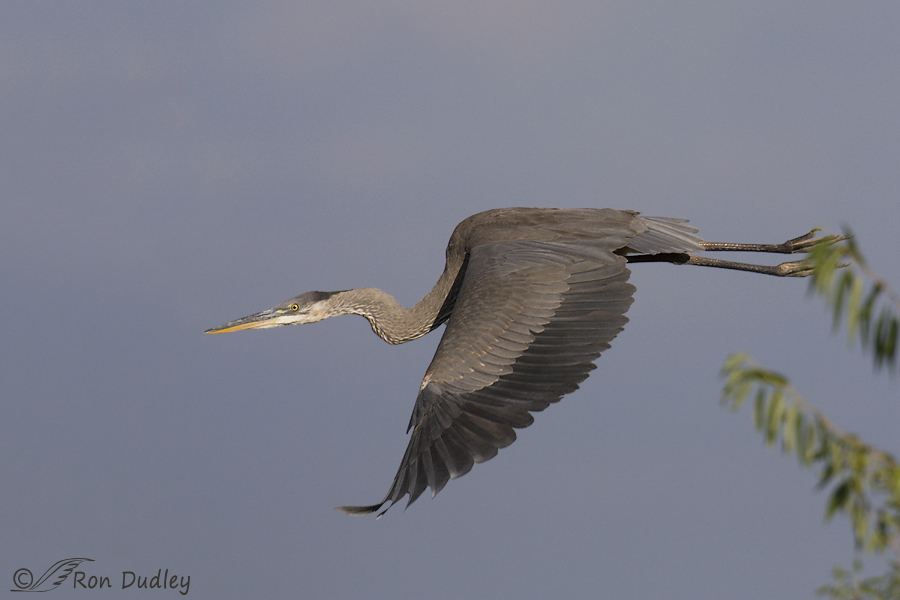In the field bird photographers often have to make snap decisions. Sometimes we make the best choice and sometimes we don’t.

1/3200, f/6.3, ISO 500, Canon 7D, Canon EF500mm f/4L IS II USM +1.4 tc, not baited, set up or called in
Three weeks ago I came across this Great Blue Heron perched at the top of a tree at Farmington Bay WMA. I was marginally too close to shoot horizontally (this version is full frame vertically) and being the greedy photographer that I am I wanted both perched and possible take-off shots so these were my choices:
-
continue to shoot horizontally where I really didn’t have quite enough vertical room in the frame for the perched bird but if it took off I had a better chance to avoid clipping body parts
-
take a few shots vertically and then switch to horizontal if the bird gave me time to do both before taking off
-
take a few shots vertically and then remove my tc to give me the best chance to avoid clipping if the bird took off. This option takes me about 5 seconds (an eternity when it comes to unpredictable birds)
I thought about it for about 3 seconds and chose the second option.

1/3200, f/6.3, ISO 500, Canon 7D, Canon EF500mm f/4L IS II USM +1.4 tc, canvas added for composition, not baited, set up or called in
I got in a couple of vertical shots but the heron chose that moment to take off so I didn’t have time to switch to horizontal. I was very lucky to get three shots of the bird in the air without clipping anything but because I was shooting vertically I had no room for composition in front of the heron. None.

1/3200, f/6.3, ISO 500, Canon 7D, Canon EF500mm f/4L IS II USM +1.4 tc, canvas added for composition, not baited, set up or called in
Once again I’m faced with choices (at least I have the time to truly think about it this time). I can trash three otherwise acceptable shots or I can add canvas in front of the heron to improve the composition. I chose the latter.

1/3200, f/6.3, ISO 500, Canon 7D, Canon EF500mm f/4L IS II USM +1.4 tc, canvas added for composition, not baited, set up or called in
So each of these last three images has canvas added.
In the end there probably was no perfect choice to make in the field in this instance, even in hindsight, because the heron just didn’t give me enough time. Bird photographers often shoot on a wing (literally) and a prayer (either literally or figuratively) and there’s just no changing that.
As I often say, bird photography isn’t easy…
Ron
An unrelated note: For some time now many folks who use Sophos Antivirus Software have been unable to access my blog. Sophos was giving a false positive for malware and denying access. I knew it was a false positive because only Sophos users had the problem and we ran 6 independent scans on both my blog and my server for viruses and malware and they came up clean every time. Sophos simply ignored our first request to reevaluate but yesterday out of deep frustration I contacted them again and within a couple of hours the problem was fixed. Please let me know if there are any issues like this in the future – for a while I didn’t even know it was happening.


I really like all of these shots. I’m guessing that take-off from the top of a tree is easier for this bird than taking off from water. This one doesn’t look anywhere near as prehistoric as the ones I watched take off from my neighborhood swamp years ago.
You are the photographer.
We are spectators.
If we like what you have produced, we’ll return to see more.
If you like the results you obtain – using all of the tools at your disposal – that’s what counts – for you.
If you feel the need to disclose how you obtained those results (which I admire) – that’s important – for you.
Like all of those who have already posted an opinion – I keep returning. I reckon we like what we see.
I happen to think all of the images in this post are outstanding photographs. Knowing the circumstances you encountered in the field enhances my personal appreciation of your effort because I’ve experienced the same circumstances. Knowing the details of your post-production is interesting but not necessary – for me. ** Your disclosure of those details speaks volumes about your character. **
** THAT is the real reason we all love your work, Ron! **
Remarkable shots Ron! Thanks for sharing!
Charlotte
‘In the field bird photographers often have to make snap decisions. Sometimes we make the best choice and sometimes we don’t.’
Sounds a bit like life to me – except that most life decisions don’t get the stunning/beautiful/amazing payoffs that your ‘good’ decisions bring.
Yup, that’s life alright, Elephant’s Child – photography is the same in at least some ways. Thank you.
Great series Ron. Most of us who try to shoot birds know the frustration of changing a setting and possibly missing the shot. I can have the right setting and still miss the shot!! Your work is always terrific. I never see a miss!!! Love the take off shots.
Believe me, Ellen, I have misses aplenty. I just don’t usually post them here. My “keeper” rate is usually significantly less than 10% Thank you.
These are wonderful shots. I love the resolution to your conundrum. I am an aspiring photographer and I struggle with bird photography so I was thrilled to find your blog a few months ago. I always learn something from your posts; your photographs are stunningly beautiful; I love your writing. I look forward to your posts every day. Thanks.
Thanks very much, Carol. I wish you luck with your photography, birds especially. They’re not easy but they sure are fun!
This is a beautiful series of shots, Ron. I’m glad you let us know what you do to allow your photographs to be more enjoyable to view and as it does not alter the bird itself, I have no problem with a little digital enhancement. Like Dick, I am just glad we live in the digital age and can take lots of shots without having to wait (and pay) for developing. I say all the time “I have a great delete finger”! Thanks for sharing.
Angela, “Delete” is my middle name. Well, that and “cull”…
As a bone fide member of camera illiterati, I can’t really identify with the problem…as a greedy blog worshipper, I’m interested in results. As an artist, I ‘m interested in what I want to convey visually, and make whatever modifications I deem necessary to achieving my goal. Whatever you did works for me…I love these images…if you photoshopped a little extra sky in front of the bird, good…makes a better picture…with nothing of real importance, anatomically or botanically changed what difference other than SLIGHTLY improved aesthetics does it make. That’s a great, big sky up there, showing a little more for the sake of better composition, is fine with me and in no way offends my ethics. Why should it?
Thanks, Patty. “Ethical edges” can sometimes be an individual thing. For example, many of the more prestigious photography contests (which I do not enter, prestigious or not) don’t allow any digital manipulation at all, other than sharpening and cropping. I’ll sometimes add canvas but I think it’s important that it be disclosed.
They may not be kind to us some times, but today, at least, we have digital and can see just afterward what we need to do to correct the problem. At least that is what is said – BUT, by the time we do that the bird, the mammal, the butterfly, etc., have gone. However, Isn’t this fun, and I don’t say that sarcastically – this really is fun. I can’t think of a better way to spend the remaining years of my life!!!
Nor can I, Dick. Nor can I…
That’s the truth, I still haven’t mastered this, still take too long deciding or if I decide before hand, it turns out faulty too many times. The God’s are watching, and waiting, and then bam!! (LOL) Hey, the whole thing about nature photography is a high for me. Never get discouraged, laugh a lot and have fun, life is too short not to do that. And, we don’t have to wait for the film to develop to see if we screwed up!!
Ron, I like your shots anyway, I think they are great!!
Thank you, Dick. I can tell from your comment that you’ve been through this many times too. Yup, “the gods” are often not kind to us…